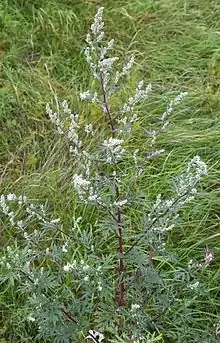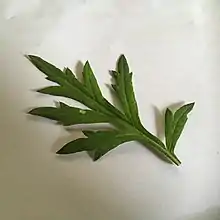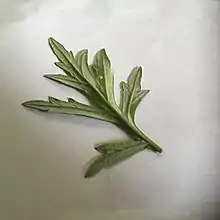| Artemisia vulgaris | |
|---|---|
 | |
| Scientific classification | |
| Kingdom: | Plantae |
| Clade: | Tracheophytes |
| Clade: | Angiosperms |
| Clade: | Eudicots |
| Clade: | Asterids |
| Order: | Asterales |
| Family: | Asteraceae |
| Genus: | Artemisia |
| Species: | A. vulgaris |
| Binomial name | |
| Artemisia vulgaris L. 1753 not C.B. Clarke 1882 nor Mattf. 1926 | |
| Synonyms[1] | |
|
Synonymy
| |
Artemisia vulgaris, the common mugwort,[2] is a species of flowering plant in the daisy family Asteraceae. It is one of several species in the genus Artemisia commonly known as mugwort, although Artemisia vulgaris is the species most often called mugwort. It is also occasionally known as riverside wormwood,[3] felon herb, chrysanthemum weed, wild wormwood, old Uncle Henry, sailor's tobacco, naughty man, old man, or St. John's plant (not to be confused with St. John's wort).[4] Mugworts have been used medicinally and as culinary herbs.
Distribution
A. vulgaris is native to temperate Europe, Asia, North Africa, and Alaska, and is naturalized in North America,[5] where some consider it an invasive weed. It is a very common plant growing on low-nitrogen soils, such as waste places, roadsides and other weedy and uncultivated areas.[6]
Uses
Traditionally, it has been used as one of the flavoring and bittering agents of gruit ales, a type of unhopped, fermented grain beverage. In Vietnam as well as in Germany, mugwort is used in cooking as an aromatic herb.
In China, the crunchy stalks of young shoots of A. vulgaris, known as luhao (Chinese: 芦蒿; pinyin: lúhāo), are a seasonal vegetable often used in stir fries.[7]
In Nepal, the plant is also called titepati (tite meaning bitter, pati meaning leaf) and is used as an offering to the gods, for cleansing the environment (by sweeping floors or hanging a bundle outside the home), as incense, and also as a medicinal plant.[8]
The dried leaves are often smoked or drunk as a tea to promote lucid dreaming. This supposed oneirogenic effect is reported to be due to the thujone contained in the plant.[9][10]
Description
A. vulgaris is a tall, herbaceous, perennial plant growing 1–2 m (3 ft 3 in – 6 ft 7 in) (rarely 2.5 m (8 ft 2 in)) tall, with an extensive rhizome system. Rather than depending on seed dispersal, it spreads through vegetative expansion and the anthropogenic dispersal of root rhizome fragments.[11] The leaves are 5–20 cm (2–8 in) long, dark green, pinnate, and sessile, with dense, white, tomentose hairs on the underside. The erect stems are grooved and often have a red-purplish tinge. The Ukrainian name for mugwort, чорнобиль (chernobyl) transliterates as "black stalk", and the Ukrainian city of Chernobyl gets its name from the plant. The small yellow or brown rayless[12] flower heads are 5 mm (3⁄16 in) long, radially symmetrical and arranged in racemose panicles. The outer flowers in each capitulum are female and the inner ones bisexual.[13] It flowers from midsummer to early autumn.[14]
Several species of Lepidoptera (butterflies and moths) such as Ostrinia scapulalis feed on the leaves and flowers of the plant.[15]
Pharmacological properties
Historically, A. vulgaris was referred to as the "mother of herbs" and has been widely used in the traditional Chinese, European, and Hindu medicine. It possesses a wide range of supposed pharmacological uses, including anticancer, anti-inflammatory, antioxidant, hepatoprotective, antispasmolytic, antinociceptive, antibacterial, antihypertensive, antihyperlipidemic, and antifungal properties.[16]
Phytochemical constituents
A. vulgaris houses a variety of phytochemicals which are responsible for its pharmacological properties. The phytochemicals belong to classes including flavonoids, essential oils, phenolic acids, coumarins, sterols, carotenoids, vitamins, and sesquiterpene lactones, among many others.[17] Examples of the phytochemicals include vulgarin, artemisinin, scopoletin, camphene, camphor, sabinene, and some derivatives of quercetin and kaempferol.[16][17]


References
- ↑ The Plant List, Artemisia vulgaris L.
- ↑ BSBI List 2007 (xls). Botanical Society of Britain and Ireland. Archived from the original (xls) on 26 June 2015. Retrieved 17 October 2014.
- ↑ English Names for Korean Native Plants (PDF). Pocheon: Korea National Arboretum. 2015. p. 361. ISBN 978-89-97450-98-5. Archived from the original (PDF) on 25 May 2017. Retrieved 25 January 2017 – via Korea Forest Service.
- ↑ "Ohio Perennial and Biennial Weed Guide: Mugwort Artemisia vulgaris". Ohio Agricultural Research and Development Center, Ohio State University. Archived from the original on 19 May 2011.
- ↑ "Plants profile for Artemisia vulgaris (common wormwood)". PLANTS USDA.gov.
- ↑ Barney, J. N.; DiTommaso, A. (2002). "The biology of Canadian weeds. 118. Artemisia vulgaris L." Canadian Journal of Plant Science. 83 (1): 205–215. doi:10.4141/P01-098.
- ↑ "Information Officee of Shanghai Municipality". Archived from the original on 26 April 2021. Retrieved 26 April 2021.
- ↑ Rysdyk, Evelyn C. (19 February 2019). The Nepalese Shamanic Path: Practices for Negotiating the Spirit World. Simon and Schuster. ISBN 978-1-62055-795-2.
- ↑ Szaro, Melissa (4 December 2020). "How to Use Mugwort for Dreams, Sleep, and More". Herbal Academy. Retrieved 18 June 2023.
- ↑ "Oneirogens - BurnZero". burnzero.com. Retrieved 18 June 2023.
- ↑ New York Invasive Species Information. "Mugwort". nyis.info. Retrieved 29 October 2019.
- ↑ Blamey, M.; Fitter, R.; Fitter, A (2003). Wild flowers of Britain and Ireland: The Complete Guide to the British and Irish Flora. London: A & C Black. p. 284. ISBN 978-1408179505.
- ↑ Stace, C. A. (2019). New Flora of the British Isles (Fourth ed.). Middlewood Green, Suffolk, U.K.: C & M Floristics. p. 790. ISBN 978-1-5272-2630-2.
- ↑ Parnell, J. and Curtis, T. 2012. Webb's An Irish Flora. Cork University Press. ISBN 978-185918-4783
- ↑ Calcagno, Vincent; Bonhomme, Vincent; Thomas, Yan; Singer, Michael C.; Bourguet, Denis (7 September 2010). "Divergence in behaviour between the European corn borer, Ostrinia nubilalis , and its sibling species Ostrinia scapulalis : adaptation to human harvesting?". Proceedings of the Royal Society B: Biological Sciences. 277 (1694): 2703–2709. doi:10.1098/rspb.2010.0433. PMC 2982046. PMID 20410041.
- 1 2 Ekiert, Halina; Pajor, Joanna; Klin, Paweł; Rzepiela, Agnieszka; Ślesak, Halina; Szopa, Agnieszka (25 September 2020). "Significance of Artemisia Vulgaris L. (Common Mugwort) in the History of Medicine and Its Possible Contemporary Applications Substantiated by Phytochemical and Pharmacological Studies". Molecules. 25 (19): 4415. doi:10.3390/molecules25194415. ISSN 1420-3049. PMC 7583039. PMID 32992959.
- 1 2 Thangjam, Nurpen Meitei; Taijong, Jasmina; Kumar, Awadhesh (9 November 2020). "Phytochemical and pharmacological activities of methanol extract of Artemisia vulgaris L. leaves". Clinical Phytoscience. 6 (1): 72. doi:10.1186/s40816-020-00214-8. ISSN 2199-1197. S2CID 226279550.
External links
- Mugwort in 'The complete herbal' Archived 13 November 2022 at the Wayback Machine by Culpeper
- Mugwort 'A modern herbal' by Mrs. Grieve
- "Artemisia vulgaris". Plants for a Future.
- Artemisia vulgaris in the CalPhotos photo database, University of California, Berkeley